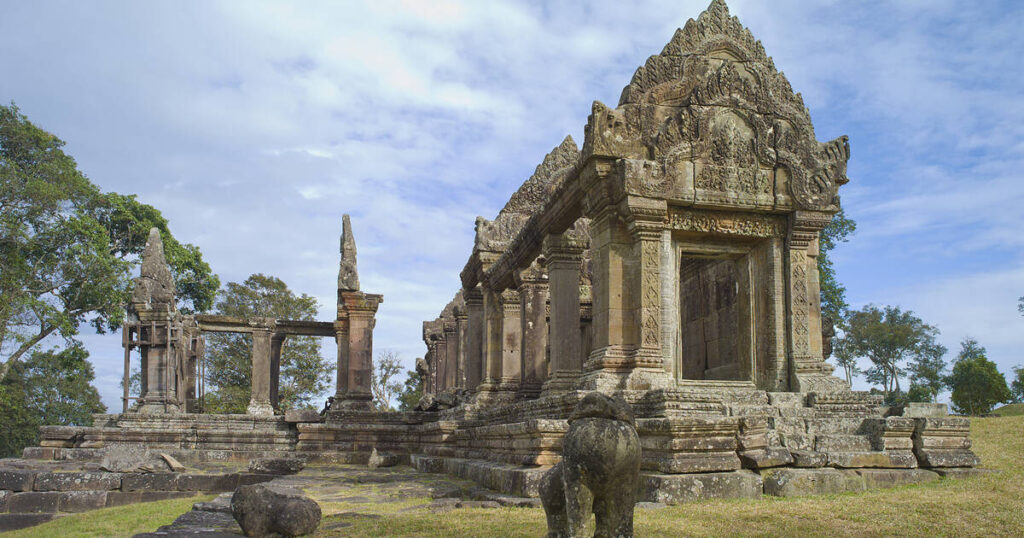Preah Vihear Temple Conflict: A Century of Dispute Between Cambodia and Thailand

🛕 History of Preah Vihear Temple
Perched 525 meters above sea level, Preah Vihear Temple was originally built as a Hindu shrine dedicated to Lord Shiva. Its history stretches back to the early 9th century during the reign of Jayavarman II. Over the centuries, successive Khmer kings expanded the site:
● King Yasovarman I (889–910 AD): Constructed the first stairways and began development.
● King Suryavarman I (1006–1050): Added major stone structures.
● Kings Udayadityavarman II, Jayavarman VI, Dharanindravarman I, and Suryavarman II: Contributed further sanctuaries and intricate carvings between the 11th and 12th centuries. The temple was not just a religious center—it was a symbol of Khmer civilization, power, and artistic brilliance.
🗺 Origins of the Conflict
Colonial Agreements (1904–1907)
In 1904, France (then ruling Cambodia) and Siam (now Thailand) signed a treaty stating that their shared border would follow the watershed line of the Dângrêk Mountains. However, in 1907, French cartographers produced a map that placed Preah Vihear Temple within Cambodian territory—slightly deviating from the watershed. Siam accepted the map at the time and raised no objection.
Post-War Nationalism and Occupation (1946–1954)
After World War II, nationalist movements surged. Cambodia gained independence in 1953, and as French forces withdrew, Thailand moved troops into Preah Vihear in 1954, citing the original watershed agreement.
Cambodia protested the occupation but, lacking military power, launched a legal and diplomatic campaign instead of confrontation.
⚖️ The 1962 International Court of Justice (ICJ) Ruling
In 1959, Cambodia took the matter to the International Court of Justice (ICJ) in The Hague. The ICJ reviewed the 1907 French map, which Thailand had tacitly accepted and used for decades. The court ruled that Thailand had recognized Cambodia’s ownership through its inaction and thus, Preah Vihear Temple belonged to Cambodia.
🏛 Key Verdict (June 15, 1962):
“Thailand is under an obligation to withdraw any military or police forces stationed at the Temple and to return any removed artifacts.”
While Thailand complied, resentment remained—particularly over the land surrounding the temple, which was not explicitly covered by the ruling.
🔥 The 2008–2011 Border Clashes
UNESCO Listing Sparks Tension
In 2008, Cambodia submitted Preah Vihear to UNESCO for recognition as a World Heritage Site. Thailand strongly objected, arguing that the application included disputed surrounding territory. Nationalist protests broke out in Thailand. Both countries increased troop presence near the temple, and armed clashes erupted in October 2008.
Escalating Military Clashes
Between 2009 and 2011, tensions boiled over:
● April 2009: Mortar fire and gun battles occurred.
● February 2011: Multi-day clashes killed soldiers and civilians; parts of the temple were reportedly damaged by Thai artillery.
Civilians were displaced, and both countries blamed each other for aggression. Cambodia appealed again to the ICJ—this time for clarification on the scope of the 1962 ruling.
🧭 The 2013 ICJ Clarification Ruling
On November 11, 2013, the ICJ issued a clarification of its 1962 judgment.
“Cambodia has sovereignty over the whole promontory of Preah Vihear,
including the immediate surrounding area.”
This ruling reaffirmed Cambodia’s control—not just over the temple, but also over the land directly adjacent to it.
While the verdict was legally binding, both sides interpreted it differently. Thailand claimed the ruling was narrow; Cambodia insisted it finally settled the matter. Troop withdrawals followed, but political and emotional divisions persisted.
🗓 Timeline Summary: Preah Vihear Conflict (1904–2013)
| Year | Event | Details |
| 1904 | France–Siam border agreement | Border to follow watershed line of the Dângrêk Mountains |
| 1907 | French map places temple in Cambodia | Thailand accepts without objection |
| 1953 | Cambodia gains independence | French forces begin withdrawal |
| 1954 | Thai troops occupy Preah Vihear | Cambodia protests; no military confrontation |
| 1959 | Cambodia files ICJ case | Seeks legal recognition of sovereignty |
| 1962 | ICJ rules in favor of Cambodia | Thailand ordered to withdraw |
| 2008 | UNESCO recognizes temple as Cambodian | Triggers new wave of protests and tensions |
| 2008–2011 | Armed border clashes | Dozens killed, temple damaged, civilians displaced |
| 2011 | Cambodia returns to ICJ for clarification | Legal request to define surrounding territory |
| Nov 11, 2013 | ICJ reaffirms Cambodian sovereignty over surrounding land | Thailand and Cambodia urged to cooperate on implementation |
📌 Conclusion: A Temple, A Legacy, A Warning
Preah Vihear Temple is more than an architectural wonder—it is a symbol of identity, memory, and contested borders. The century-long conflict between Cambodia and Thailand is a cautionary tale of how colonial-era maps, nationalist pride, and unresolved diplomacy can entangle culture with conflict.
Despite legal victories, physical skirmishes, and global mediation, the dispute reminds us that international law can settle boundaries, but it takes political will—and cultural respect—to heal the wounds left behind.
🧭 Suggested Reading & Resources
● ICJ Case Files on Preah Vihear (1962 & 2013)
● UNESCO World Heritage Profile: Preah Vihear Temple
